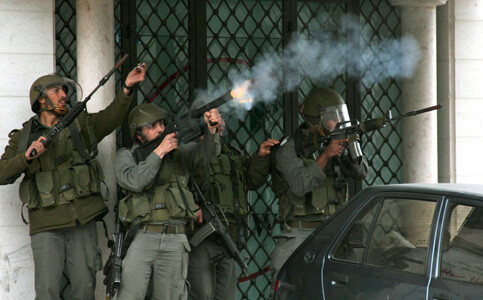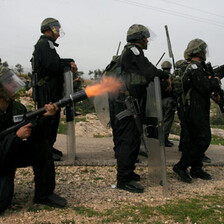The Electronic Intifada 14 January 2009

Israeli soldiers fire tear gas at Palestinians in the West Bank city of Hebron protesting the ongoing Israeli offensive in Gaza, 9 January 2009. (Mamoun Wazwaz/MaanImages)
RAMALLAH, occupied West Bank (IPS) - A number of armed attacks have taken place on Israel’s borders with Palestinian territories in the last six days as Arab public anger over the death and destruction wrought on Gaza spills over from massive street demonstrations.
Israeli security officials have voiced concern that the Gaza violence could affect Israel’s borders and that Israeli settlers and soldiers in the Palestinian West Bank could be targeted by armed Palestinians.
Last Thursday a barrage of Katyusha rockets from southern Lebanon were fired at Nahariya in northern Israel. Lebanese group Hizballah denied any involvement, and it is suspected that the attack was carried out by some smaller pro-Palestinian organizations.
On Sunday a Syrian man fired two gunshots at Israelis repairing the border fence between the two countries.
On Monday morning three Israeli soldiers were lightly injured when suspected Palestinian gunmen fired shots at their military vehicle in the militant Jewish settlement Kiryat Arba, near Hebron, 30 km south of Jerusalem.
According to Israeli reports a Jordanian soldier opened fire on an Israeli border patrol Tuesday morning near the resort city Eilat in southern Israel. Israeli soldiers returned fire. The Jordanian army denied that any incident had occurred.
Analysts and military strategists have written off these incidents as isolated events carried out by individuals and small groups acting alone. However, the massive street demonstrations and the Arab anger over the death of more than 900 Palestinians, most of them civilian, and the wounding of more than 3,000, do not bode well for Israel’s future relationship with its neighbors.
Meanwhile, Israel’s attitude towards demonstrators on the streets of Israel and in the occupied Palestinian West Bank has hardened.
Israeli officials have declared a zero-tolerance policy towards what they see as incitement during anti-war street demonstrations. Hundreds of Palestinians with Israeli citizenship have been arrested and imprisoned after taking part in street protests.
Last Friday Israeli troops in Bilin village, near the central West Bank city Ramallah, fired on demonstrators with live ammunition.
Weekly demonstrations, against Israel’s “security” wall which separates Palestinian farmers in Bilin from their land, have been attended by Israelis, international sympathizers and Palestinian villagers for several years.
Despite an Israeli court ruling that the wall had to be rerouted to lessen the negative financial and social impact on the villagers, the Israeli army has so far failed to implement the court’s decision.
The International Court of Justice at The Hague ruled in 2004 that the route of the wall was illegal. The route taken by the barrier diverges significantly into Palestinian territory off the Green Line, which is the internationally-recognized border between Israel proper and the occupied West Bank.
Prior to Operation Cast Lead on 27 December, Israeli soldiers mostly used tear gas and rubber bullets (marble-sized metal balls covered in half a millimeter of rubber) to subdue the protestors and stone-throwers in Bilin.
Although several demonstrators have been killed by rubber bullets fracturing their skulls, this ammunition is less deadly than live ammunition. Last Friday Israeli snipers wounded eight protestors using Ruger .22 rifles.
The lethal Ruger .22 rifle was banned in 2001 by then Israeli military advocate-general Menahem Finkelstein.
While tensions on Israel’s borders and within the West Bank ratcheted up, Israel was reportedly on the verge of expanding its Gaza operation into a third and even more deadly phase.
Fierce ground battles between Palestinian resistance fighters and Israeli soldiers were reported Tuesday morning. Israeli troops, backed by artillery and Apache attack helicopters, moved into neighborhoods inside Gaza city for the first time during the invasion.
About 30 Palestinians were killed at time of going to press on Tuesday. Twenty Palestinians lost their lives on Monday, 60 died on Sunday.
As the Gaza battles raged, Israel’s war troika of Foreign Minister Tzipi Livni, Defense Minister Ehud Barak and Prime Minister Ehud Olmert appeared divided about withdrawal from Gaza and how to deal with Hamas.
Livni, worried about the bashing Israel’s reputation is receiving as Palestinian civilian casualties skyrocket, is in favor of a withdrawal from Gaza as early as possible if military goals are reached. Barak, the main architect of the Gaza military incursion, also favors early withdrawal.
Olmert, on the other hand, appears to be in no hurry to pull back troops. He is piling the pressure on Egypt, and has said that nothing short of cessation of rocket fire from Gaza and the elimination of weapons smuggling from Egypt into Gaza would lead to a ceasefire.
While Barak appears more open to the possibility of one day having to negotiate with Hamas, all three would nevertheless be happy to see the resistance organization destroyed completely.
Ironically, Israel originally encouraged the establishment of Hamas in 1987, both politically and financially, as a bulwark against the popularity of the Palestine Liberation Organization (PLO). Today Israel supports the Palestinian Authority, which is affiliated with the PLO, against Hamas.
Avigdor Lieberman, a right-wing Israeli politician suggested on Tuesday at Tel Aviv’s Bar Ilan University that extreme measures were needed against Hamas. “We must continue to fight Hamas just like the United States did with the Japanese in World War II,” Lieberman said.
The Israeli media quoted him as saying that the US nuclear strikes on Japan had rendered an “occupation of the country unnecessary.”
All rights reserved, IPS - Inter Press Service (2009). Total or partial publication, retransmission or sale forbidden. Jim Lobe in Washington contributed to this article.
Related Links





